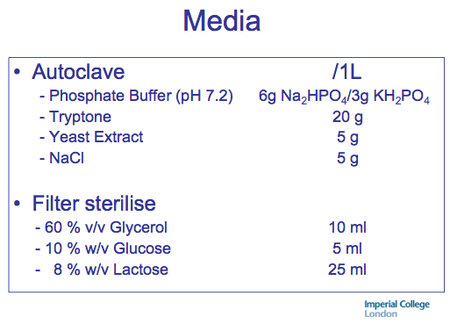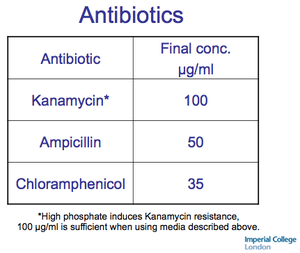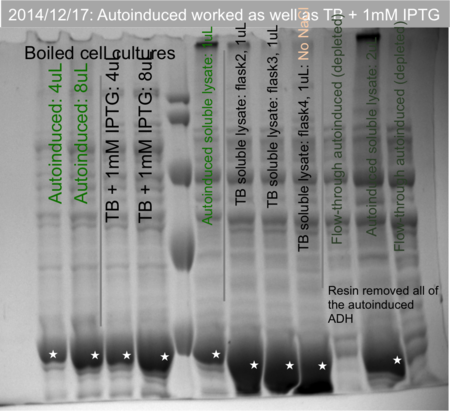Lidstrom:Autoinduction Media: Difference between revisions
| Line 58: | Line 58: | ||
**"To shorten the total incubation time, we typically grow cultures for a few hours at 37 °C until they become lightly turbid (less than OD 600nm ~1) and then transfer them to the lower temperature. It is a good idea to continue incubation of cultures grown overnight at low temperature and to read the culture density a few hours apart to be sure that they are saturated." | **"To shorten the total incubation time, we typically grow cultures for a few hours at 37 °C until they become lightly turbid (less than OD 600nm ~1) and then transfer them to the lower temperature. It is a good idea to continue incubation of cultures grown overnight at low temperature and to read the culture density a few hours apart to be sure that they are saturated." | ||
* "Auto-induction works over the entire temperature range from 18 to 37 °C, an advantage because some target proteins are substantially more soluble when expressed at lower temperatures. However, care must be taken to ensure that auto-induction is complete before harvesting cultures grown at the lower temperatures. Saturation densities are usually significantly higher than at 37 °C, presumably because of the higher solubility of oxygen at the lower temperatures." | * "Auto-induction works over the entire temperature range from 18 to 37 °C, an advantage because some target proteins are substantially more soluble when expressed at lower temperatures. However, care must be taken to ensure that auto-induction is complete before harvesting cultures grown at the lower temperatures. Saturation densities are usually significantly higher than at 37 °C, presumably because of the higher solubility of oxygen at the lower temperatures." | ||
*"In general, increasing the rate of aeration increases the density at which auto-induction begins and the density at which the culture saturates. Higher aeration also increases the minimum con- centration of lactose needed for good induction. The standard 0.2 % lactose was chosen to be well in excess of that needed for good auto-induction over the range of conditions tested. Auto- induced culture densities greater than OD 600nm ~50 have been attained by using higher levels of glycerol, higher levels of aeration, and appropriate metabolic balancing of pH with aspartate or succinate." | |||
Revision as of 07:43, 31 March 2015
Return: Protocols
About Autoinduction media
- Glucose and the inducing sugar are present in the media while the cells grow. In the beginning, the cells prefer glucose. As the glucose runs out, the cells start taking up the induction sugar (usually lactose), causing induction of genes related to that sugar's metabolism (e.g. lac promoter, pTrc promoter, T7 promoter).
- Can also be done with arabinose or galactose.
The advantages are:
- you don't have to monitor OD of the cultures
- you can go straight from -80oC to protein purification in 1 day instead of two
- great for library screening where cultures have different growth rates
Use for T7 and pTrc
Instead of inducing a T7 or pTrc promoter with IPTG, autoinduction media can be used. Glucose, glycerol, and lactose are added to a buffered yeast broth to make autoinduction media. As the E. coli cultures grow, they consume the glucose first. As the glucose runs out, they are forced to use the lactose which drives expression of the T7 promoter. Glycerol helps support growth without inhibiting T7 protein expression.
Recipe:

Autoinduction Media recipe from Studier 2005. 
Autoinduction Media antibiotic specificiations. - Recipe in action -JM
References
- Original Paper: Studier FW (2005), Protein Production by Auto-Induction in High-Density Shaking Cultures. Protein Expr. Purif. 41(1): 207–234. <-- we make media ZYM-5052.
- A more practical recap of the original paper by the same author 7 years later: Stable Expression Clones and Auto-Induction for Protein Production in E. coli (free version (?))
- Practical summary slides: Imperial college .ppt slides: http://www3.imperial.ac.uk/pls/portallive/docs/1/15699698.PPT
Comparing autoinduction media to TB induced with IPTG
Janet did an experiment in 12/2014 comparing cell pellets of His-tagged ADH grown in autoinduction media to the same culture grown in TB and induced with IPTG as part of this experiment. The autoinduced culture had comparable amounts of protein as seen by SDS-PAGE, and yielded more protein upon Co-NTA purification.
Questions
Why is glycerol added?
"Glycerol is provided in auto-inducing media as a good carbon and energy source that does not prevent glucose depletion during growth, glucose exclusion of inducing sugars, or the uptake of inducing sugars upon glucose depletion." -- Sturdier 2014
How good does the oxygenation need to be?
See Stable Expression Clones and Auto-Induction for Protein Production in E. coli, which says you will get more protein with more oxygen. I think you still get good yields if they are fermenting but you will get even more if they aren't.
How does temperature affect the process?
See Stable Expression Clones and Auto-Induction for Protein Production in E. coli, which points out that oxygen is more soluble at lower temperatures. It may take longer to get to induction but the final OD and amount of protein produced may also be higher.
How to use other sugars (than lactose)
"The standard 0.2 % lactose selected initially for auto-inducing media [ 6 ] corresponds to 5.6 mM, which equates to 0.1 % galactose. Induction of the pBAD pro- moter in these media is effective at 0.05 % arabinose." -- Sturdier 2014
Other notes
- "Expression strains suitable for auto-induction must have functional transporters for the appropriate sugar. Induction by lactose requires active β-galactosidase to convert lactose to allolactose, the actual inducer, and a functional LacY transporter. Induction by galactose would not require active β-galactosidase, but the host strain must lack galactokinase activity and transport galactose well enough to achieve an intracellular concentration sufficient for inducing promoters blocked by lac repressor. IPTG is not suitable for use in auto-induction because it can enter the cell and induce expression without a specific transporter, and cultures cannot grow uninduced in the presence of IPTG." -- Sturdier 2014
- "Growth media contain 50 mM phosphate, which provides signifi cant buffering and supports growth to high densities."
- "The effectiveness of kanamycin as a selective agent against the growth of BL21(DE3) decreases with increasing concentration of phosphate in rich media [ 6 ]: 100 μg/ml of kanamycin is needed to assure killing in the media given here."
- Sturdier 2014 uses very high air:culture ratios:
- "Reasonably good aeration is important for maintaining meta- bolically balanced pH near neutral and obtaining growth to high cell densities. We typically grow cultures in a temperature- controlled rotary shaker at ~350 rpm, using vessels and volumes of culture that give approximately equivalent levels of aeration. For auto- induction of many cultures in parallel to test expres- sion and solubility, we grow 0.5 ml cultures in 13 × 100 mm glass culture tubes with plastic caps in the rotary shaker-incubator upright in plastic racks that hold up to 72 tubes. At the scale we work, this is much more convenient and controllable than using multi-well microtiter plates. However, microtiter plates can be used in high-throughput automation if aeration is properly addressed."
- "Moderate-scale auto-induction can use 400–500 ml of culture in 1.8-l baffled Fernbach flasks (Bellco)."
- "In general, auto-inducing cultures are inoculated with one-thousandth volume from a culture grown to saturation in non- inducing MDAG-135 from a freezer stock." -- Sturdier 2014
- The high dilution allows the entire culture to be growing uniformly by the time autoinduction begins.
- Cultures grown at 37 °C are typically grown overnight for 12–16 h, well past saturation. Saturation in ZYM- 5052 at 37 °C typically reaches an OD 600nm around 7–10 but can reach 20–30 in some highly expressing strains.
- Incubation for several hours at saturation after auto-induction usually has little effect on accumulation or solubility of target proteins.
- "To shorten the total incubation time, we typically grow cultures for a few hours at 37 °C until they become lightly turbid (less than OD 600nm ~1) and then transfer them to the lower temperature. It is a good idea to continue incubation of cultures grown overnight at low temperature and to read the culture density a few hours apart to be sure that they are saturated."
- "Auto-induction works over the entire temperature range from 18 to 37 °C, an advantage because some target proteins are substantially more soluble when expressed at lower temperatures. However, care must be taken to ensure that auto-induction is complete before harvesting cultures grown at the lower temperatures. Saturation densities are usually significantly higher than at 37 °C, presumably because of the higher solubility of oxygen at the lower temperatures."
- "In general, increasing the rate of aeration increases the density at which auto-induction begins and the density at which the culture saturates. Higher aeration also increases the minimum con- centration of lactose needed for good induction. The standard 0.2 % lactose was chosen to be well in excess of that needed for good auto-induction over the range of conditions tested. Auto- induced culture densities greater than OD 600nm ~50 have been attained by using higher levels of glycerol, higher levels of aeration, and appropriate metabolic balancing of pH with aspartate or succinate."
